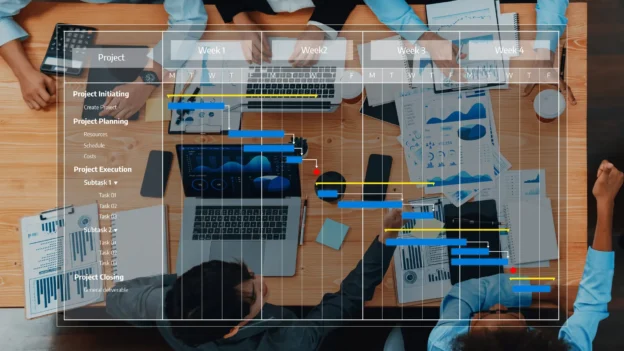In an increasingly dynamic business environment, where digital transformation and globalization are redefining business models, innovation project management has become an essential component of organizational competitiveness. Innovation is not just about generating ideas, but structuring a process that turns them into real value, integrating creativity, strategy, and effective methodologies.
In this article, we will explore what innovation project management is, the most effective methodologies, such as Design Thinking and Scrum, and also the role of the project manager in contexts where a culture of innovation is the basis for sustainable growth.
What is innovation project management?
Innovation project management can be defined as the process by which an organization plans, executes, and evaluates innovative initiatives that transform ideas into solutions with tangible impact.
This type of management integrates creative processes, strategic thinking, and collaborative leadership to turn creativity into measurable results.
What innovation is and what it is not
Innovation is not synonymous with whimsy or isolated change. It involves turning an idea into value through a systematic and structured process that produces a new, useful, and sustainable result. Innovating means transforming knowledge into solutions that generate impact: new products, services, processes, business models, or forms of organization.
Not every improvement is innovation. Adjusting a procedure, optimizing a resource, or automating a task may represent efficiency, but not necessarily innovation. To be considered innovation, it must cause a significant change in performance, user experience, or value proposition.
In other words, innovation is about changing the nature of something, not just its speed. It is about creating something that did not exist before or that existed in a different form, integrating creativity, method, and strategic purpose.
As Ruiz and Mandado (1989) explain, “innovation is the result of rational, premeditated, systematic, and organized work,” encompassing scientific, technical, and commercial activities aimed at successfully introducing new products, processes, or services.
Milles and Morris (1999) add that innovation is “transforming invention into something commercially useful and valuable,” while Schumpeter, cited by Ortiz and Pedroza (2006), broadens the vision to include “new forms of organization, markets, and sources of raw materials.”
For his part, Huber (2001) argues that innovation management begins when “an inventive solution solves a market problem within the business strategy.”
In summary, managing innovation involves aligning creativity with strategy (strategic alignment) and developing a structure that combines technical knowledge, business vision, and adaptability.
Innovation methodologies and frameworks
1. Design Thinking
Design Thinking is a methodology focused on people and the process of designing solutions, rather than on the final product.
According to Brown and Wyatt (2010), its purpose is to gain a deep understanding of the user’s knowledge, expectations, and emotions in order to develop a meaningful design based on that understanding. To achieve this, interactive prototypes are used to observe how users relate to ideas before defining the final version.
From a more reflective perspective, Gasca (2015) argues that Design Thinking seeks to unite rational thinking with intuition, promoting a framework that transcends traditional deductive logic. This approach encourages a type of abductive reasoning, aimed at exploring new or previously unconsidered solutions.
This method represents an ideal strategy for exploring ideas and making innovative decisions, completely transforming the way we think and design. It is about designing with people, not just for them, enhancing collective creativity and co-creation through multidisciplinary teams.
According to Rosch (2023), three basic phases can be considered as the fundamental stages of any DT process:
- Data collection on the problem.
- Idea generation.
- Idea testing.
In short, Design Thinking is much more than a creative tool: it is a philosophy of applied innovation that combines empathy, analysis, and experimentation. Its value lies in its ability to integrate diverse perspectives, transform uncertainty into opportunities, and convert a deep understanding of the user into tangible solutions.
2. Scrum
Scrum is an agile framework that organizes work into short, repetitive sprints, where teams deliver functional increments of the product, learn from feedback, and continuously adapt their course.
The fundamental roles in Scrum are:
- Product Owner: defines the project vision and priorities.
- Scrum Master: guides the team, removes obstacles, and promotes continuous improvement.
- Development team: executes tasks and delivers consistent value.
Practical example: Scrum in an innovation project
A sustainable food startup seeks to launch a line of biodegradable packaging. It divides the project into three-week sprints, each with specific goals: materials research, strength testing, customer validation, and final packaging design.
The Scrum Master organizes daily 15-minute meetings to review progress, and at the end of each sprint, a retrospective is held to identify improvements.
In just four months, the team will go from an initial idea to a functional prototype validated by the market, reducing time and costs by up to 25%.
Therefore, applying Scrum will enable uncertainty to be converted into learning, accelerating the innovation process and fostering stakeholder engagement.
How to implement innovation project management
To apply innovation effectively, you must understand the project lifecycle and structure it with iterative and measurable phases:
- Identify opportunities: detect needs, trends, or market gaps.
- Define innovation objectives and KPIs: measure impact, learning, and value generated.
- Select methodology: choose between Design Thinking, Scrum, or hybrid models.
- Form multidisciplinary teams: integrate creativity, technique, and strategy.
- Prototype and validate: experiment, fail fast, and learn.
- Consolidate learning: integrate results into the organizational culture.
In this way, the innovation process ceases to be an isolated event and becomes a living system of continuous learning.
The role of the project manager in innovative contexts
The innovation project manager acts as a catalyst for change. Their leadership combines strategic thinking, agile management, and human sensitivity.
Key competencies
- Agile and strategic thinking to prioritize learning.
- Stakeholder engagement management.
- Promoting a culture of innovation.
- Mastering agile and digital tools.
- Value orientation and strategic alignment.
The innovative leader inspires, connects, and shapes change, transforming creativity into sustainable results.
Conclusions
Innovation project management represents the convergence between method and creativity. Methodologies such as Design Thinking and Scrum demonstrate that innovation involves a systematic process that requires purposeful management of creativity, measuring results using innovation KPIs, and consolidating learning within the organization.
The key lies in combining structure with flexibility, fostering a culture of innovation that is capable of adapting, evolving, and generating real impact in the markets.
References
- Brown, T., & Wyatt, J. (2009). Design Thinking for Social Innovation. Stanford Social Innovation Review, 8(1), 31–35. https://doi.org/10.48558/58Z7-3J85
- Chavarría Briceño, R. (2023). Gestión de proyectos e innovación [Project Management and Innovation]. Revista FAECO Sapiens, 6(2), 142–161. Universidad de Panamá. https://revistas.up.ac.pa/index.php/faeco_sapiens
- Gasca, J. (2015). Design Thinking: Afrontar los retos con la actitud de un diseñador. Leaners Magazine, 8, 22–25. http://www.leanersmag.com/docs/publicaciones/08-design-acting/design-thinking.pdf
- Huber J. C. (2001) Managing Innovation: mining for nuggets, Autors Choice Press, USA.
- Miller, W., Morris, L. (1999). 4th Generation. R&D. Managing Knowledge, Technology, and Innovation, John Wiley & Sons, Inc. USA.
- Ortiz, J., & Pedroza, A. (2006). ¿Qué es la gestión de la innovación y la tecnología? Journal of Technology Management & Innovation, Vol. 1, No. 2. https://rei.iteso.mx/server/api/core/bitstreams/dbe921f6-1e87-44d5-b99c-48fa872c5611/content
- Rösch, N., Tiberius, V., & Kraus, S. (2023). Design Thinking for Innovation: Context Factors, Process, and Outcomes. European Journal of Innovation Management, 26(7), 160–176. https://doi.org/10.1108/EJIM-03-2022-0164
- Ruiz, M., & Mandado, E. (1989). La innovación tecnológica y su gestión. Universidad de Vigo.
- Terribili Filho, A., Bortoleto Nery, A. C., & Bentancor, A. L. (2015). Gestión de proyectos de innovación en las instituciones educativas privadas en San Pablo. REXE. Revista de Estudios y Experiencias en Educación, 14(27), 85-103. https://www.redalyc.org/pdf/2431/243143345006.pdf


